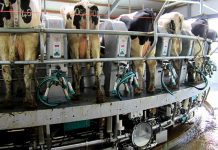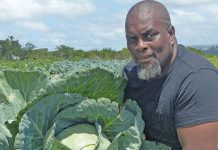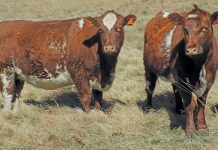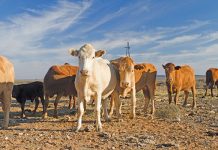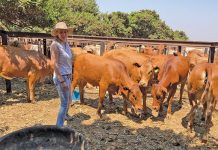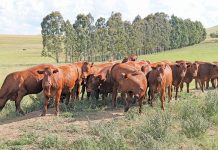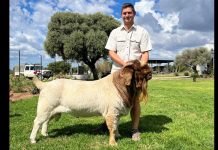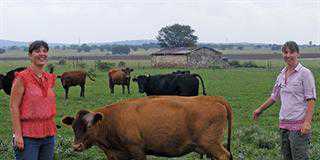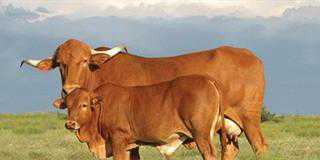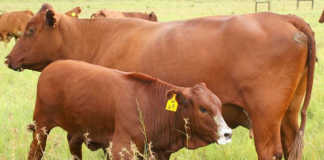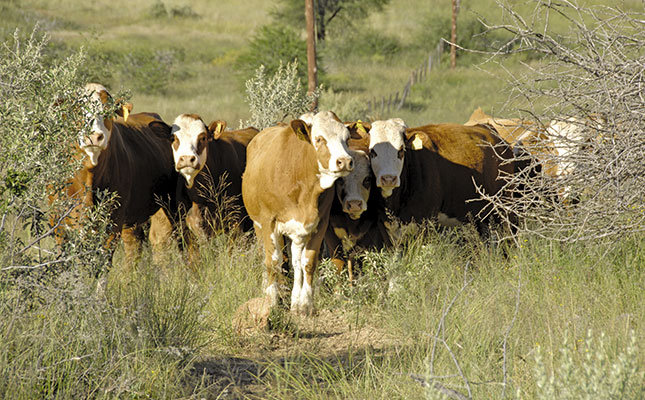
The first Simmentalers in Southern Africa were imported to Namibia in 1893. Twelve years later, MT Steyn, the last president of the independent republic of the Orange Free State and a cattle breeder, took delivery of the first examples of the breed in South Africa. He had encountered the ‘Simmental’, as it was then known, in Switzerland in the years after the Anglo-Boer War (1899-1902) and had been so impressed that he was determined to make it the nucleus of his herd on his farm, Onze Rust. Steyn owned the first registered Simmentaler bull in South Africa, Toni.
In the many years since then, the Simmentaler has played a major role in the development of the cattle industry in Southern Africa, explains Stephan Voigts, current president of the Namibian branch of the Simmentaler/Simbra Breeders’ Society of Southern Africa.
The name Simmentaler is derived from the Simme river valley (‘tal’ in German) in Switzerland, where the breed originated. The animal is a descendant of the auroch (Bos taurus primegenius), a bovine indigenous to Europe. The Simmentaler’s distant relationship with Zebu, Sanga and British breeds renders it an ideal breed for cross-breeding due to this high degree of heterosis (hybrid vigour).
The famous swiss export
The Simmentaler was once Switzerland’s most important export product. From 1900 to 1929, approximately 150 000 Simmentalers were exported to European countries for its multi-purpose characteristics of milk, beef and as a draught animal.
According to the Simmentaler commemorative publication, the first Simmentalers were shipped from Germany to German South-West Africa (now Namibia) by a syndicate known as the ‘Sindikat für Siedler’. Pioneer cattleman Ernst Rusch in the Khomas Hochland near Windhoek bought one of these bulls as a cornerstone of the Lichtenstein Simmentaler stud on the farm Lichtenstein-west. The stud is now owned by Reini Rusch, the fourth generation to continue Ernst Rusch’s legacy.
Initially, the Simmentalers were used for milk and beef production as well as for draught purposes, and have evolved over the decades to a medium-framed, hardy breed well adapted to Southern African conditions, says Reini. “The Southern African Simmentaler excels on local grazing conditions. Our Simmentalers are fast growers with high weaning weights. The Simmentaler cow is an excellent milker with strong maternal instincts. Simmentaler bulls are veld-adapted and quick growing,” he explains.
The first Simmentalers in South-West Africa disembarked at Swakopmund. In itself this was a considerable feat as there was no pier at that stage (the pier was built only in 1902). The cattle had to be offloaded from the ship anchored offshore, swim to shore and then trek 80km from the coast across the Namib Desert to Otjimbingwe. Horseshoes had to be fitted for the next trek from Windhoek to Okahandja.
Only cattle with strong hooves and great walking ability survive in Namibia, as they often have to walk 10km or more to reach water, says Stephan. “The Namibian Simmentaler developed into a strong, hardy animal that thrives under the most demanding conditions.”
Stephan is the great grandson of Gustav Voigts, founder of the Voigtland Simmentaler Stud, who bought the farm Voigtland on the outskirts of Windhoek in 1895. Following the example of his grandfather Gerhard, president of the Namibian branch of the Simmentaler/Simbra Breeders’ Society of Southern Africa in 1963, Stephan is currently the society’s president.
Gustav chose the Simmentaler because of its strong resistance to disease. The breed proved its worth during the 1896 Rinderpest outbreak, when it proved to be the most resistant of all imported breeds to the disease.
According to the commemorative history, the Simmentaler Breeders’ Association formed in 1919 in Kalkfeld is probably the oldest Simmentaler breeders’ society outside Europe. Early settlers such as Paul Albert Friedrich, Otto Kleiber and Fritz Becker initially farmed indigenous Damara (or Lierhoring as they were known then) cattle.
A variety of stud bulls subsequently imported from the Union of South Africa and Germany further improved the breed. One example was a Simmentaler bull and a number of heifers, imported from Germany to Kalkfeld in 1904/1905. The constitution of the then South West Simmentaler Breeders’ Society was published in 1930. By 1949, however, only 11 animals had been registered with that society.
War in Europe
The importation of Simmentalers from Europe effectively came to a standstill between and during the two world wars. According to retired Simmentaler/Simbra Breeders’ Society of Southern Africa director, Peter Massmann, pioneers such as Voigts, Rusch, Kaiser and Rust acted as custodians of the Simmentaler during these difficult years.
This was followed by a decision in 1950 to form the Simmentaler Breeders’ Society of Southern Africa, which would include South African breeders. The official recognition of the second society was published in a Government Gazette in 1964. The society also joined SA Stud Book. In 1990, the society moved away from SA Stud Book to BreedPlan.
Research proves breed’s value
The Simmentaler began to claim its stake in the Namibian beef cattle industry when the results of a 10-year research programme at the Omatjenne Research Station near Otjiwarongo were published in 1951, recalls Stephan. The trials, which compared 10 breeds, covered traits such as fertility, adaptability, growth up to the age of three years, carcass traits and profitability.
“The Simmentaler excelled in these trials and has since then firmly established itself in meeting the demands of commercial cattleman in Namibia,” Stephan says. The first Simmentaler National Championships were held in Pretoria in 1966. The judges were Dr Gerd Engelhard (Germany), S Roth (Austria) and Reheul Borstlap (Namibia). The bull Sieg (26811) bred by Boet Claasen, was the Senior Champion and Grand Champion Bull at the championships. The Senior Champion and Grand Champion Cow, Eva (46611), was entered by JCG Johnstone from Amersfoort.
Another highlight in the Southern African Simmentaler history was the World Simmentaler Congress in Pretoria in 1976, followed by a second in 2009. The Simmentaler/Simbra Breeders’ Society of Southern Africa was the first organisation of its kind to offer courses on BLUP genetic evaluations to its selectors. Breeding values were first used in the showring in 1999 and the society became one of the first to do away with the outdated ‘mother and father’ registration certificates in favour of modern animal performance-based registration.
Crossbreeding
Due to the outstanding performance of crossbred Simmental and Brahmans, the Simmentaler Breeders’ Society of Southern Africa decided to change its constitution in the 1980s to include the Simbra. The first F1s were registered in 1986 (bull Nestau 851 and heifer Lichtenstein L135 – both ¾ x ¼).
In the mid-1970s, the Southern Africa Simmentaler/Simbra Breeders’ Society of Southern Africa was the first to introduce the intercalving period (ICP) as a criterion in judging cows. This led to the development of the Simdex (SIMmentaler reproduction inDEX) value in the 1980s. The age at last calving, number of calvings, intercalving period and, if applicable, number of embryo flushings are expressed as a single comparative Simdex value. Simbradex applies to the Simbra breed.
Kobus Bester, current Simmentaler/Simbra Breeders’ Society of Southern Africa SA chairman, says the future of cattle breeding depends on the implementation of precision farming practices, namely the use of advanced technologies to optimise the contribution of each animal. This will include using phenotypically well-adapted and well-balanced cattle which will dictate the future of the Simmentaler.
“The successful Simmentaler breeders of the future will be those who implement precision farming practices and select on feed conversion rate,” he says. “Increased production of saleable beef will increasingly determine profitability.” Flaf Lauwrens, Simmentaler/Simbra Breeders’ Society of Southern Africa breed director, says that the Southern African Simmentaler has developed into a white and dark red, medium-framed animal with well-pigmented areas around the eyes. It is naturally polled with a smooth coat and has outstanding walking ability.
“Simmentaler bulls are the kings in crossbreeding. Pure as well as crossbred Simmentaler weaners are in great demand in feedlots. Rapid growth and exceptional weight increase are its two most important characteristics.
“The Simmentaler cow is an excellent mother, highly fertile and a top milker.
“This is the breed for the future,” concludes Lauwrens.
Source: Simmentaler 1964–2014 (ISBN:978-0-86886-828-8)
Phone the Simmentaler/Simbra Breeders’ Society of Southern African on 051 446 0580 or email [email protected].

